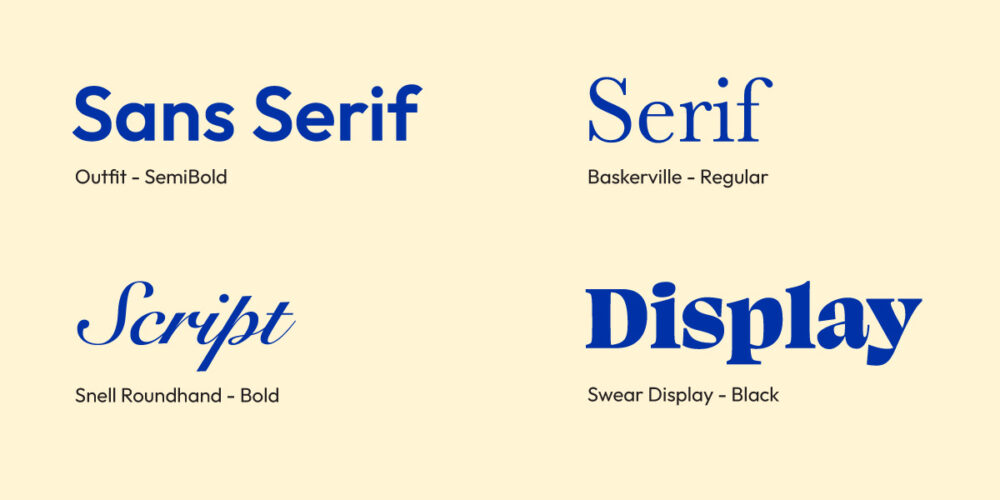Brand identity refers to the visual, verbal, and emotional elements that collectively represent a brand and distinguish it from others. It’s the way a brand presents itself to the world and encompasses various components that contribute to its overall persona and image.
Establishing a strong and consistent brand identity is crucial for building brand recognition, fostering customer loyalty, and creating a positive brand image in the market. A well-defined brand identity helps consumers connect with the brand, understand its values, and differentiate it from competitors. And it’s imperative that brands exhibit their visual branding across every platform – website, social media, internal communications, marketing materials, advertising, and more.
Key elements of a cohesive brand identity
Brand identity elements are the individual components that collectively contribute to the overall image and perception of a brand. These elements help differentiate a brand from its competitors and create a consistent and recognizable presence in the minds of consumers. Here are some key brand identity elements:
- Logo: A unique and recognizable symbol or design that represents the brand. For example, Coca-Cola’s scripted font and iconic wave design conveys a sense of tradition, and the flowing nature of the wave suggests the refreshing and effervescent qualities of its beverages.
- Color palette: The specific set of colors associated with the brand, which helps create a consistent and cohesive visual identity.
- Typography: The chosen fonts and styles used in the brand’s communication materials, such as logos, websites, and advertisements.

- Imagery: The types of photos, illustrations, or graphics associated with the brand, conveying a specific style or tone.
- Packaging: The design and materials used for product packaging, often in the ecommerce industry.
Brand elements aren’t always visual elements or tangible icons. Beyond a brand name, these elements should be a reflection of a brand’s personality.
- Messaging: The language, tone, and style used in communication, including taglines, slogans, and the overall brand voice.
- Values and mission: The core principles and purpose that the brand stands for, often communicated through mission statements and brand value propositions.
- Customer experience: The overall impression and emotions evoked by interacting with the brand, whether through products, services, or customer support.
Companies with strong brand identity
Apple: Apple’s branding, known for simplicity and innovation, features a bitten apple logo synonymous with minimalism and elegance. Consistency in design spans product, packaging, advertising, and retail spaces, fostering a cohesive brand image. Apple’s immersive retail experience complements sleek layouts with hands-on staff. Overall, Apple’s brand establishes it as a global leader in technology.
Nike: Nike’s brand is globally recognized for its iconic elements, with a dynamic Swoosh logo symbolizing movement and speed. The “Just Do It” slogan embodies determination and empowerment, resonating with athletes and consumers. Nike’s bold color palette and distinctive product design create a visually memorable brand. Beyond products, Nike excels in cultivating immersive customer experiences and partnerships. Overall, Nike’s brand is a powerful fusion of motivational messaging and a commitment to athletic excellence.
Developing a successful brand image
Whether a large enterprise, startup or small business, designing a brand identity (or launching a rebrand) involves several strategic steps to ensure a cohesive and memorable representation of your brand. Here is a step-by-step guide:
Define your brand: Clearly articulate your brand’s mission, values, and personality. Understand your target audience and what sets your brand apart from competitors.
Conduct market research: Research your industry, competitors, and target audience. Identify trends, preferences, and gaps that can inform your design decisions.
Establish messaging and tone: Develop a comprehensive brand strategy that outlines key elements, such as brand positioning, messaging, and the emotional tone you want to convey.
Logo design: A graphic designer can develop a unique and memorable logo that encapsulates your brand essence. Consider colors, shapes, and symbols that align with your brand personality and resonate with your target audience.
Choose brand colors and fonts: Select a color scheme that reflects your brand’s personality and is visually appealing. Choose a typeface that compliments your design and is consistent with your brand voice.
Establish an online presence: Extend your brand identity to your online platforms, including your website and social media profiles. Ensure that your digital presence aligns with your overall brand aesthetic.
Create a brand experience: Ensure that every touchpoint with your brand provides a positive and consistent experience. This includes customer interactions, product and service delivery.
Test and iterate: Seek feedback from stakeholders, employees, and customers. Use this feedback to make refinements to your brand identity if necessary.
Launch and promote: Launch your brand (or rebrand) across all relevant digital channels. Use various marketing strategies to promote your brand and create awareness.
Monitor and evolve: Regularly assess the effectiveness of your brand identity. Monitor consumer perceptions and market trends. Be open to evolving your brand identity as your business grows and market dynamics change.
Managing your brand’s visual elements
A Digital Asset Management (DAM) system is crucial for supporting a brand identity strategy. It centralizes all assets, ensures consistency through brand guidelines, and prevents the use of outdated versions with version control. Digital asset management facilitates seamless collaboration, automates workflows, and enhances brand asset security. Its scalability supports growing brand portfolios, and global accessibility allows secure access from anywhere. Analytics features provide insights for data-driven decisions, making the DAM system an essential tool for brand management.
Ready to develop a strong brand identity? Get started with PhotoShelter today.